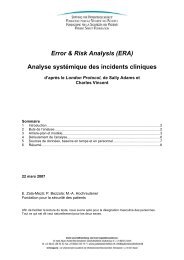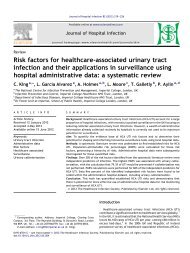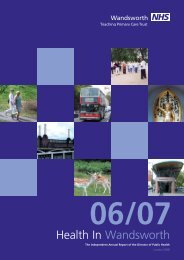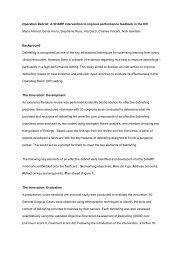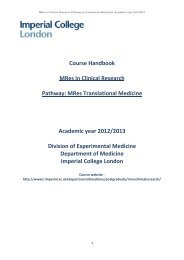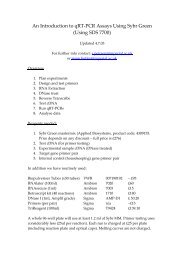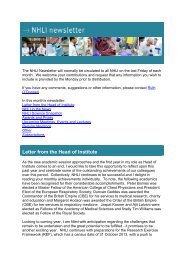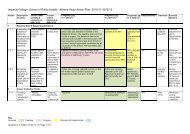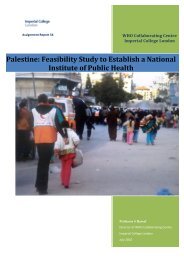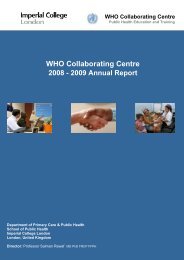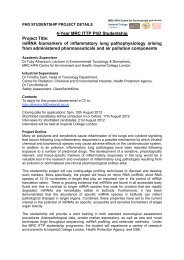QOF Plus Year 1 - Imperial College London
QOF Plus Year 1 - Imperial College London
QOF Plus Year 1 - Imperial College London
Create successful ePaper yourself
Turn your PDF publications into a flip-book with our unique Google optimized e-Paper software.
Appendix 4Methodology for the design and development of thenew indicators for <strong>QOF</strong>+Methodology for the creation of new indicator areas long listTo inform development of new <strong>QOF</strong>+ indicators, a member of the group conducted an initialreview of the existing literature on quality improvement in health care settings, and ondevelopment of quality indicators. The methodology chosen for development of the new clinicalindicators drew on the methodology for reviewing the Quality and Outcomes Framework –the<strong>QOF</strong> Review (Lester, 2006) and for developing indicators for the quality of health promotion,prevention and primary care at the health systems level in OECD countries (Marshall et al., 2004).The <strong>QOF</strong> Review is an independent academic process which advises the NHS Employees and GPnegotiators on a range of evidence based clinical indicators. This Review is a collaborationbetween the Universities of Birmingham and Manchester, the Society of Academic Primary Careand the Royal <strong>College</strong> of General Practitioners.Potential local, national, and international sources for new indicator areas were identified andconsidered. Local data sources included the NHS Hammersmith and Fulham public health report(Zeuner, 2008), PCT Operating Plan 2008/9 (Hammersmith and Fulham PCT, 2008) and localenhanced service schemes (Hammersmith and Fulham PCT, 2008). National data sources includedthe Healthcare Commission Key Performance Indicators (Healthcare Commission, 2008), NHSVital Signs indicators (DoH, 2008) and recent national guidance, including that produced by theNational Institute for Health and Clinical Excellence (NICE), as well as considering topicsaddressed by other Local Enhanced Services schemes nationally. The OECD indicators developedfor use in a primary care setting were also considered (Marshall et al., 2004). Selected localstakeholders including the Local Director of Public Health were consulted to seek their views onpotential approaches for creation of the long list. The members of the <strong>QOF</strong>+ Development Group,which included GPs and Consultants in Public Health, contributed additional ideas for potentialnew indicator areas. Documentation from NHS Hammersmith and Fulham’s Patient and PublicInvolvement Forum was also reviewed to gain a perspective on the views of local patients inorder to help inform the process (Hammersmith and Fulham PCT, 2007). A full formalconsultation with local stakeholders including primary care and patients was not performed atthis stage however, due to the time restraints and subsequent tight deadlines that the group wasworking within.Following discussion within the <strong>QOF</strong>+ development group, it was decided that areas wouldinitially be included on the long list if they were identified as either a local or national priorityarea. The group agreed that an area would be defined as a local priority if it was highlighted inthe NHS Hammersmith and Fulham Annual Public Health Report (Zeuner, 2008). A nationalpriority area would be defined by its inclusion as a Key Performance Indicator by the HealthcareCommission (Healthcare Commission, 2008). It was agreed that a key theme of <strong>QOF</strong>+ should bethe focus on reducing health inequalities locally. The PCT public health report focuses on areasrelevant to health inequalities locally, and these were therefore used to help identify potentialnew indicator areas for <strong>QOF</strong>+ (Zeuner, 2008). Following discussion within the <strong>QOF</strong>+ developmentgroup, with the PCT and with national experts in quality improvement, it was felt that due to the130



